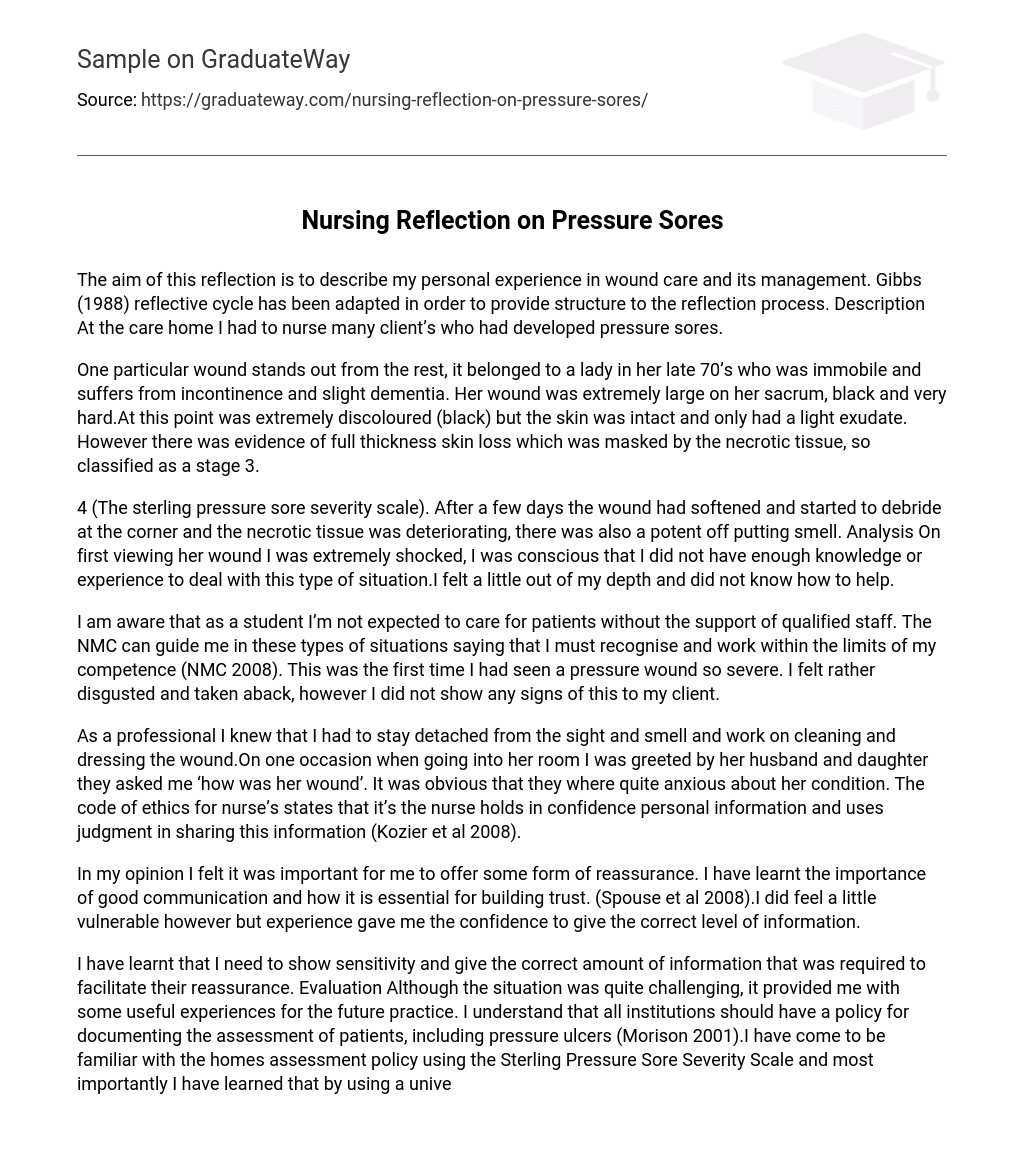The aim of this reflection is to describe my personal experience in wound care and its management. Gibbs (1988) reflective cycle has been adapted in order to provide structure to the reflection process. Description At the care home I had to nurse many client’s who had developed pressure sores.
One particular wound stands out from the rest, it belonged to a lady in her late 70’s who was immobile and suffers from incontinence and slight dementia. Her wound was extremely large on her sacrum, black and very hard.At this point was extremely discoloured (black) but the skin was intact and only had a light exudate. However there was evidence of full thickness skin loss which was masked by the necrotic tissue, so classified as a stage 3.
4 (The sterling pressure sore severity scale). After a few days the wound had softened and started to debride at the corner and the necrotic tissue was deteriorating, there was also a potent off putting smell. Analysis On first viewing her wound I was extremely shocked, I was conscious that I did not have enough knowledge or experience to deal with this type of situation.I felt a little out of my depth and did not know how to help.
I am aware that as a student I’m not expected to care for patients without the support of qualified staff. The NMC can guide me in these types of situations saying that I must recognise and work within the limits of my competence (NMC 2008). This was the first time I had seen a pressure wound so severe. I felt rather disgusted and taken aback, however I did not show any signs of this to my client.
As a professional I knew that I had to stay detached from the sight and smell and work on cleaning and dressing the wound.On one occasion when going into her room I was greeted by her husband and daughter they asked me ‘how was her wound’. It was obvious that they where quite anxious about her condition. The code of ethics for nurse’s states that it’s the nurse holds in confidence personal information and uses judgment in sharing this information (Kozier et al 2008).
In my opinion I felt it was important for me to offer some form of reassurance. I have learnt the importance of good communication and how it is essential for building trust. (Spouse et al 2008).I did feel a little vulnerable however but experience gave me the confidence to give the correct level of information.
I have learnt that I need to show sensitivity and give the correct amount of information that was required to facilitate their reassurance. Evaluation Although the situation was quite challenging, it provided me with some useful experiences for the future practice. I understand that all institutions should have a policy for documenting the assessment of patients, including pressure ulcers (Morison 2001).I have come to be familiar with the homes assessment policy using the Sterling Pressure Sore Severity Scale and most importantly I have learned that by using a universal assessment tool it supports a systemic and consistent approach to pressure ulcer evaluation.
This therefore supporting continuity of care. I have significantly developed my skill in wound care assessment and dressing, in developing this skill I now recognize the importance of documenting each dressing.Morison (2001) supports this in saying that by detailing pressure ulcer assessment it provides a basis for deciding the effectiveness of the current treatment. Conclusion Skin tears and pressure ulcers are frequently seen in the elderly and care home residents are prime candidates (Stephen-Haynes 2009).
Callaghan (2009) as stated in Haynes (2009) reports a 7. 9% incidence across care homes. Evidence has shown this is due to a high prevalence of immobility and malnutrition. However the incidence of pressure ulcers is not unique to nursing homes but also within a hospital setting.
I have learnt that it is fundamental that As a nurse working in any care setting I need to be aware of the risk assessment of my patients in developing pressure ulcers. Where there is already a pressure ulcer present I need to develop further my ability to assess correctly document and choose the precise form of treatment. But also I recognise that these skills are till in the early stages of development therefore I will draw upon the experience of my fellow senior nurses to aid my competence in this area.





